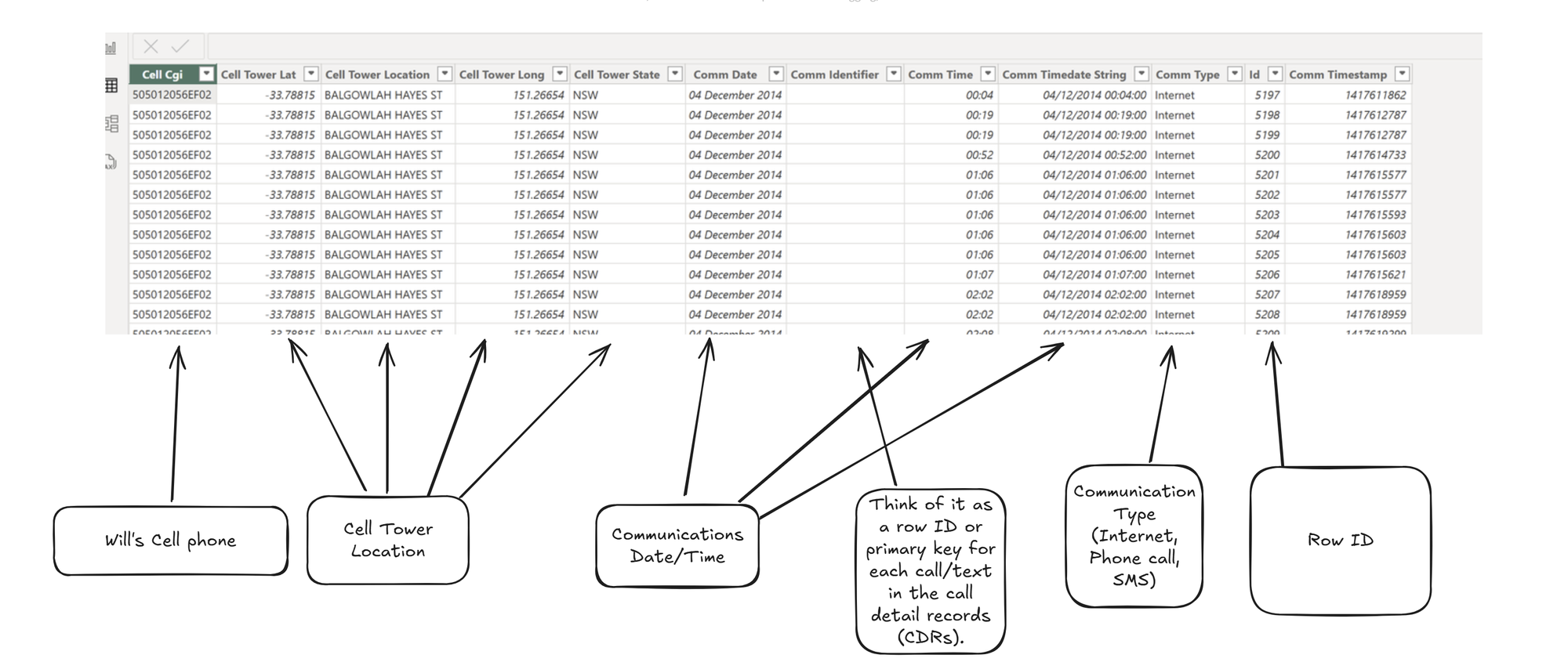In 2015, Australian reporter Will Ockenden shared his own cellphone metadata to highlight just how much of someone’s life can be pieced together under Australia’s data retention laws—even without access to the actual calls or messages.
Today, I worked with a dataset containing Will’s phone metadata: every call, text, internet session, and the cell towers he connected to. Using Power BI, I built visuals that let me step into his world through these digital traces:
- Where Will spends his time: Mapping his tower connections revealed clear hotspots that strongly suggest where he lives, works, and even where family might be.
- Daily rhythms: By grouping activity by hour, I could see his routine—when he’s most active, and how predictable his patterns are.
- Who he contacts: Scatter plots of calls vs. texts showed his most frequent connections and whether he leans toward phoning or messaging.
- Unusual activity: Spikes in usage and movements away from “home” towers hinted at travel, holidays, and breaks from routine.

Each row in the dataset logs a unique interaction with a cell tower, including its location, date, time, and communication type (call, text, internet). Using this and Power BI I mapped Will’s movements and uncovered insights into his lifestyle.
Key Insights:
- Where he lives: The clearest pattern came from the Balgowlah region of Sydney, NSW. His phone connected to towers there at all times of day—late at night, early mornings, and across weekends, which strongly suggests this is where he lives
- Where he works: His second-most used tower is in Chippendale, right next to Sydney’s Central Station, the city’s busiest transport hub. The fact that most of these interactions occurred between 9am and 5pm, Monday to Friday, points to his workplace being in Central Sydney. This also gives insight into his daily routine: commuting between Balgowlah and Central/Chippendale on weekdays.
- After-work routine: Another interesting hotspot emerged in Redfern, just south of Central. His phone regularly connects here on Tuesday and Wednesday evenings around 6–7pm. This suggests it’s part of his weekly routine, potentially visiting a gym, a friend, or any other recurring event
- Family: In the Christmas period of December 2014, there’s a noticeable spike in his phone activity at Sydney Airport, then Hobart Airport, and finally within Hobart, Tasmania. This strongly suggests he travelled to Tasmania to visit family over the holidays. The timing points to a family connection rather than just a normal trip.
- Holiday/leisure trips: The data also revealed activity in Beechworth, Victoria, clustered only on Fridays, Saturdays, and Sundays. With some research I found the town has a reputation for hiking trails, waterfalls, and outdoor activities, it’s likely this was a weekend getaway for nature trips or possibly, visiting friends in the region.
Method:
To break down Will’s communication patterns, I first created hourly bins by formatting the time field:
- HourBins = FORMAT(HOUR([comm time]), "00") & ":00"
- This formats each hour of the day as 00:00, 01:00 etc
- Created day of the week column
- Built measures to track the volume of calls and texts:
- Calls Count = CALCULATE( COUNTROWS('WhereisWill (1)'), 'WhereisWill (1)'[Comm Type] = "Phone")
- Text Count = CALCULATE( COUNTROWS('WhereisWill (1)'), 'WhereisWill (1)'[Comm Type] = "SMS")
- Created an average text/calls measure:
- Average TextCount = AVERAGEX('WhereisWill (1)',[Text Count])
- built a “most contacted” category to flag the people with whom Will interacted more than average, combining both call and text frequency:
- High Text and Calls = IF( [Calls Count] > [Average CallCount] && [Text Count] > [Average TextCount], "High Text & Calls", "")
